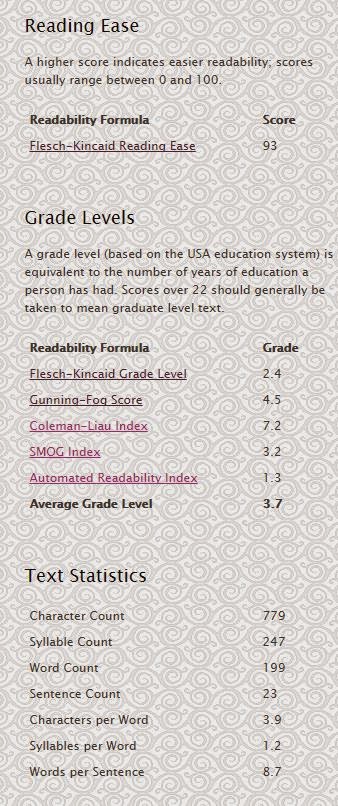 |
I blame Kristen Fulton's wonderful nonfiction picture book writing class, Nonfiction Archaeology, for my fixation.
I am familiar with writing nonfiction for magazines, but writing nonfiction picture books is a different animal for me. To help me get into the zone, I've immersed myself in nonfiction picture books. Below are few of my favorite (recent) reads that I am using as mentor text.
What you do is copy and paste your completed text in the box and hit enter on your keyboard. The site will analyze your story and give you the following information:
What's useful about this information is that you will know if your writing is targeted to the population you intended to write for.
The Flesch-Kincaid Reading Ease tells you the difficulty of your text:
90.0-100.0 Easily understood by an average 11-year-old student
60.0 - 70.0 Easily understood by an average 13-15-year-old student
0.0 - 30.0 Easily understood by a university student
Grade Level or Readability Formula Score: There is a mathematical way to determine these scores. You don't have to get caught up with each of these. All you need to know is the average grade level of the student your text is appropriate for.
Text Statistics is always fun, but the most useful is word count and words per sentence. As a writer, you want to make sure you vary your sentence length and keep within the word count that is suggested on submission guidelines.
Here are a few more sites I found helpful for studying mentor text:
- Identify whether you are a student, parent, teacher, or librarian (it doesn't matter)
- In the "Quick Search" tab, enter the title of the book you are studying
- Your result will look like this:
- Click on the title and you get an expanded form of the results:
- Go to the "Quiz Store"
- Enter title of the book you want to study and hit "Go!"
- Select the correct title displayed
 |
| I apologize for the small and blurry screen shot |
To help you decipher the codes, here is a cheat sheet:
Interest Level (IL): This indicates the grade level the book is appropriate for, based on book content (theme, character, plot). Lower Grade indicates grade level K-3, Middle grade: 4-8, and upper grade: 9-12.
Book Level (BL): This represents the difficulty of the text. It means the text could be read independently by a student whose reading skills are at the grade level indicated.
AR Points (Accelerated Reader Points): This is based on the difficulty and length of the book. A point value system measures how much reading practice your child is getting. Not important, but thought you'd want to know.
The difference between the Renaissance Learning site and the AR Book Finder is that the AR Book Finder includes a rating of the book, judged by students based on enjoyment. It also includes a topic-subtopic, which is useful to know if you want to know how the book is sorted or categorized.
My top three Readability Score sites:
Readability-score
AR BOOK FINDER
Renaissance Learning
Readability-score
AR BOOK FINDER
Renaissance Learning
Give the links a test ride and tell me what you think!





Thanks for those awesome links, Romelle! I'll bookmark them for future reference. :)
ReplyDeleteIn fact, I'll bookmark your post too so I'll know what you said about those sites!
DeleteGlad you found it helpful.
DeleteYou be working hard! This is the best post on really detailing how to use those resources.
ReplyDeleteThanks, Lauri!
DeleteAre you focusing on biography or concept or things or events or animals or whatevs? I can be on the look out for good books too and recommend them on goodreads :)
DeleteHey Romelle. So good to see you. I agree with Teresa. I am definitely bookmarking. What an excellent post. I have a few non-fiction ideas in this wild and crazy brain of mine. Thank you for such a fantastic post.
ReplyDelete